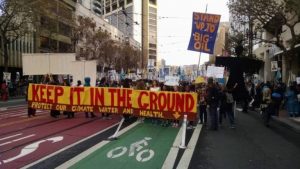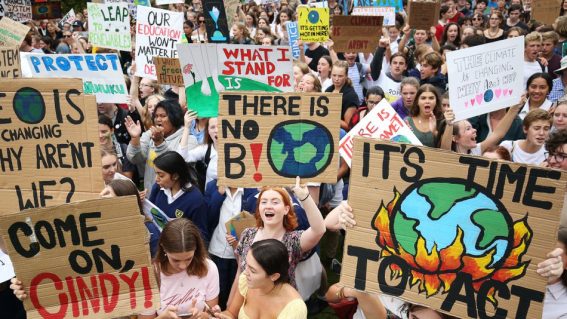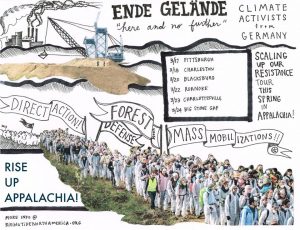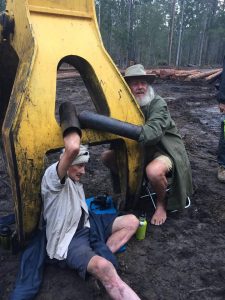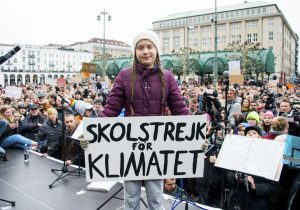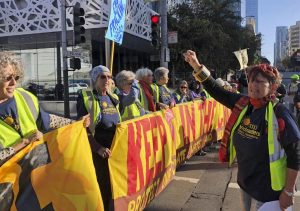
Grandmothers affinity group holding down an intersection during the Global Climate Action Summit protests in September 2018. Pic via Diablo Rising Tide
Cross-posted from Diablo Rising Tide
Diablo Rising Tide (DiRT) is excited to for the Global Climate Strike in September. We’re partnering with Idle No More SF Bay, Extinction Rebellion San Francisco Bay, the Society of Fearless Grandmothers, the 1000 Grandmothers and others to call for actions during the week of September 23rd through September 27th.
Through this process, we’re encouraging the creation of “affinity groups” to organize and take collective action against the climate profiteers and the politicians that love them.
To learn more about the long powerful tradition of affinity groups in challenging the root causes of so many ills in our world, we put together this helpful guide on them.
Please check it out. Form an affinity group with your friends and get involved.
AFFINITY GROUPS & ACTION SUPPORT
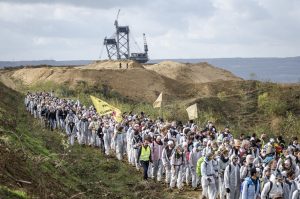
German climate action group, Ende Gelaende, used affinity groups to shut down this massive open pit coal mine.
What is an Affinity Group?
An affinity group is a small group of 5 to 20 people who work together autonomously on direct actions or other projects. You can form an affinity group with your friends, people from your community, workplace, or organization. If you are planning to do civil disobedience, it is a good idea to either form an affinity group or join an already existing one. Affinity groups serve as a source of support and solidarity for their members. Feelings of being isolated or alienated from the movement, the crowd, or the world in general can be alleviated through the familiarity and trust which develops when an affinity group works and acts together. By generating this familiarity, the affinity group structure reduces the possibility of infiltration by outside provocateurs. However, participants in an action should be prepared to be separated from their affinity group. Affinity groups form the basic decision-making bodies of mass actions. As long as they remain within the action guidelines, affinity groups are generally encouraged to develop any form of participation they choose.
Affinity groups challenge top-down decision-making and organizing, and empower those involved to take creative direct action. Affinity groups allow people to “be” the action they want to see by giving complete freedom and decision-making power to the affinity group. They generally use consensus decision-making. Affinity groups by nature are decentralized and non-hierarchical, two important principles of anarchist organizing and action. The affinity group model was first used by anarchists in Spain in the late 19th and early 20th century, and was re-introduced to radical direct action by anti-nuclear activists during the 1970s, who used decentralized non-violent direct action to blockade roads, occupy spaces and disrupt “business as usual” for the nuclear and war makers of the US. Affinity groups have been used by AIDS activists, solidarity movemenst, lesbian/gay liberation movement, the global justice movement, and many others who use non-hierarchical structures and consensus decision making in direct action and organizing.
What is a Cluster and a Spokescouncil?
A cluster is a grouping of affinity groups that come together to work on a certain task or part of a larger action. Thus, a cluster might be responsible for blockading an area, organizing one day of a multi-day action, or putting together and performing a mass street theater performance. Clusters could be organized around where affinity groups are from (example: Texas cluster), an issue or identity (examples: student cluster or anti-sweatshop cluster), or action interest (examples: street theater or [black bloc]).
A spokescouncil is the larger organizing structure used in the affinity group model to coordinate a mass action. Each affinity group (or cluster) empowers a spoke (representative) to go to a spokescouncil meeting to decide on important issues for the action. For instance, affinity groups need to decide on a legal/jail strategy, possible tactical issues, meeting places, and many other logistics. A spokescouncil does not take away an individual affinity group’s autonomy within an action; affinity groups make their own decisions about what they want to do on the streets. Spokes are empowered to communicate the decisions of their affinity group, and if issues arise that have not been discussed or consensed-upon, spokes go back to their affinity groups to reach consensus first together, then return to the spokescouncil
Roles Within the Affinity Group (These roles are typically rotated)
– Facilitator(s), vibes-watchers, timekeepers for meetings.
– Spokesperson to convey affinity group (A.G.) decisions to core support, in spokescouncils, and other A.G.’s in a mass action.
– Support person(s)- once you take on this responsibility for an action, you should see it through.
Doing Support
For all direct actions and demonstrations, it is crucial to have designated people in support roles. For direct action and civil disobedience, support people are needed by those risking arrest. In actions where no one is planning on risking arrest, support roles are also important to think out in advance, both for taking on necessary tasks during legal actions, and to prepare for the contingency of unexpected arrests. Whether you are organized into an affinity group, action squad, bloc, or just a busload of people from the same town, certain people should commit to staying out of the center of action so as to support others taking more risk. It is helpful to have a team of people share this responsibility.
Support roles for demonstrations include:
- Scouts: scope out other areas, rumors, and situations and report information back to the group.
- Tactical team: a couple of trusted group members who can think quickly in the face of changing scenarios and make recommendations for group to act.
- Communications: someone with 2-way radio, cell phone, &/or bike that can communicate with other groups within action and help coordinate.
- Medics: have first aid kit and know how to use it.
- Legal observers: will pay close attention to details useful for legal defense later.
- De-escalators: people good at defusing problems with police or others.
- Traffic: people who are empowered to stop cars at intersections and in general watch out for the safety of people on the streets from cars and other vehicles.
Arrest support people should:
BEFORE AN ACTION
- Know everyone in the group by name, description, and if used, by alias.
- Have written down pertinent information for each member on needs in case of arrest: medical needs, phone number, who to contact & when, and any other home support needs such as pet care.
- Have all this information, ID’s if group intends to practice jail solidarity, keys, money, and other belongings stored at a remote location from the action.
- Know where arrestees are likely to be taken and have transportation to get there.
- Give your contact & back-up information to each group member
- Know the phone numbers for legal, medics, media, and action support.
DURING AN ACTION
- Give any emergency information about yourself to another support person
- Meet and recheck plans and needs with group
- Have pens and paper to take legal observation notes
- Once the first person in your group is arrested, one support person should follow them, and another support person should stay near group until all are arrested.
- Once all have been arrested or are out of risk, call legal and give information.
AFTER ARRESTS
- Go to processing facilities and attempt to find out if your people are all there.
- Be visible to police so they know the arrestees are not alone.
- Try to find out what the charges are.
- Make calls you have been asked to make in the case of arrest.
- Try to find out emotional and physical states of those inside, whether they are non-cooperating and to what extent, if they want a lawyer, and liaise with legal team.
- Help hold vigil outside of jail until all are released. Have food for self and those released available.
- Attend court proceedings and keep track of all that happens.
- Coordinate rides for those released.
###



